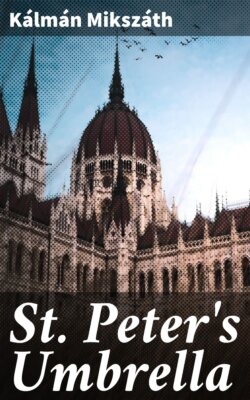Читать книгу St. Peter's Umbrella - Kálmán Mikszáth - Страница 4
INTRODUCTION
ОглавлениеKálmán Mikszáth, perhaps the most purely national, certainly, after Jókai, the most popular of all the Magyar novelists, was born at Szklabonya, in the county of Nográd, on January 16th, 1849. Educated at Rimaszombáth and Pest, he adopted the legal profession, and settled down as a magistrate in his native county, where his family had for generations lived the placid, patriarchal life of small country squires. A shrewd observer, with a strong satirical bent and an ardent love of letters, the young advocate made his début as an author, at the age of twenty-five, with a volume of short stories, which failed, however, to catch the public taste. Shortly afterward he flitted to Szeged, and contributed to the leading periodical there a series of sketches, whose piquant humor and perfection of style attracted so much notice as to encourage a bookseller in the famous city on the Theiss to publish, in 1881, another volume of tales, the epoch-making "Tót Atyafiak," which was followed, four months later, by a supplementary volume, entitled "A jó palóczok." Critics of every school instantly hailed these two little volumes as the finished masterpieces of a new and entirely original genre, the like of which had hitherto been unknown in Hungary. The short story had, indeed, been previously cultivated, with more or less of success, by earlier Magyar writers; but these first attempts had, for the most part, been imitations of foreign novelists, mere exotics which struck no deep root in the national literature. Mikszáth was the first to study from the life the peculiarities and characteristics of the peasantry among whom he dwelt, the first to produce real, vivid pictures of Magyar folk-life in a series of humoresks, dramas, idylls—call them what you will—of unsurpassable grace and delicacy, seasoned with a pleasantly pungent humor, but never without a sub-flavor of that tender melancholy which lies at the heart of the Hungarian peasantry. And these exquisite miniatures were set in the frame of a lucid, pregnant, virile style, not unworthy of Maupassant or Kjelland. Henceforth Mikszáth was sure of an audience. In 1883 he removed to Pest, and in the following year a fresh series of sketches, "A tisztelt házból," appeared in the columns of the leading Hungarian newspaper, the "Pesti Hirlap," which established his reputation once for all. During the last twelve years Mikszáth has published at least a dozen volumes, and, so far, his productivity shows no sign of exhaustion. The chief literary societies of his native land, including the Hungarian Academy, have all opened their doors to him, and since 1882 he has been twice, unanimously, elected a member of the Hungarian Parliament, in the latter case, oddly enough, representing a constituency vacated by his illustrious compeer and fellow-humorist, Maurus Jókai. Fortunately for literature, he has shown no very remarkable aptitude for politics. When I add that in 1873 Mikszáth married Miss Ilona Mauks, and has two children living, who have frequently figured in his tales, I have said all that need be said of the life-story of this charming and interesting author.
As already implied, the forte of Mikszáth is the conte, and as a conteur he has few equals in modern literature. "A jó palóczok," in particular, has won a world-wide celebrity, and been translated into nearly every European language except English, the greater part of the Swedish version being by the accomplished and versatile pen of King Oscar. But Mikszáth has also essayed the romance with eminent success, and it is one of his best romances that is now presented to the reader. "Szent Péter esernyöje," to give it its Magyar title, is a quaintly delightful narrative in a romantic environment of out-of-the-world Slovak villages, with a ragged red Umbrella and a brand-new brass Caldron as the good and evil geniuses of the piece respectively. The Umbrella, which is worth a king's ransom, is sold for a couple of florins to the "white Jew" of the district, becomes the tutelary deity—or shall I say the fetish?—of half a dozen parishes, and is only recovered, after the lapse of years, by its lawful owner, when, by a singular irony of fate, it has become absolutely valueless—from a pecuniary point of view. The Caldron, on the other hand, which is erroneously supposed to contain countless treasures, and is the outcome of a grimly practical joke, proves a regular box of Pandora, and originates a famous lawsuit which lasts ten years and ruins three families—who deserve no better fate. How the Umbrella and the Caldron first come into the story the reader must be left to find out for himself. Suffice it to say that grouped around them are very many pleasant and—by way of piquant contrast—a sprinkling of unpleasant personages, whose adventures and vicissitudes will, I am convinced, supply excellent entertainment to all lovers of fine literature and genuine humor.
R. NISBET BAIN.
